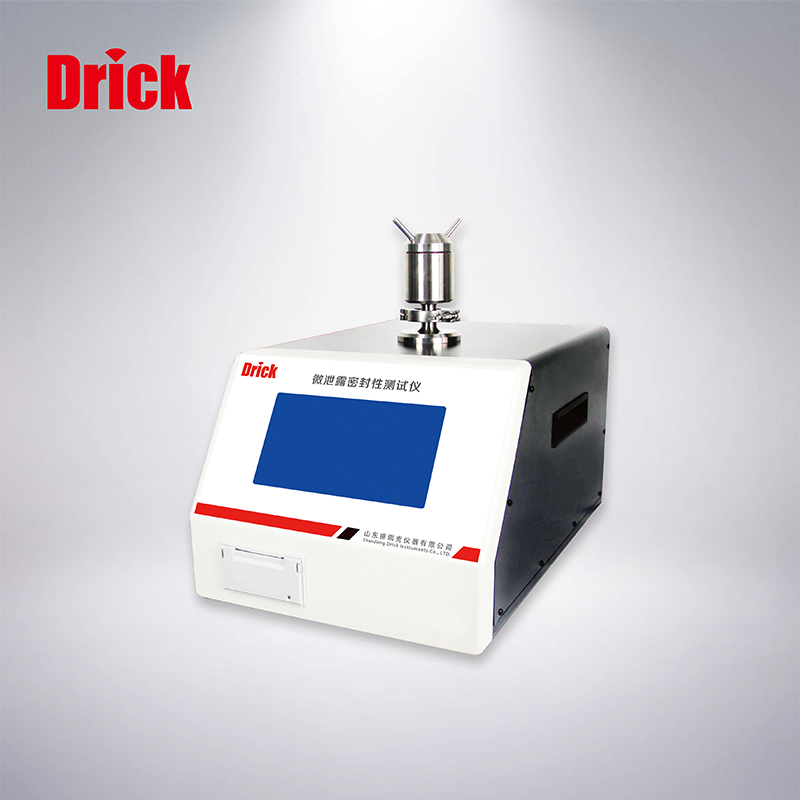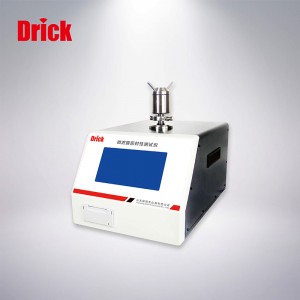Micro Leak Tightness Tester
Test items: Non-destructive inspection of packaging tightness by vacuum decay method
Fully comply with FASTM F2338-09 standard and USP40-1207 regulatory requirements, based on dual sensor technology, the principle of vacuum attenuation method of dual-circulation system. Connect the main body of the micro-leak tightness tester to a test cavity specially designed to contain the packaging to be tested. The instrument evacuates the test cavity, and a pressure difference is formed between the inside and outside of the package. Under the action of the pressure, the gas in the package diffuses into the test cavity through the leak. The dual sensor technology detects the relationship between time and pressure and compares it with the standard value. Determine whether the sample leaks.
Product Features
Leading the development of the industry. The corresponding test chamber can be selected for different test samples, which can be easily replaced by users. In the case of satisfying more types of samples, the user’s expenses are minimized, so that the instrument has better test adaptability.
The non-destructive testing method is used to conduct leak detection on the packaging containing the medicine. After the test, the sample is not damaged and does not affect the normal use, and the test cost is low.
It is suitable for detecting small leaks, and can also identify large leak samples, and give a judgement of qualified and unqualified.
The test results are non-subjective judgments. The test process of each sample is completed in about 30S, without manual participation, to ensure the accuracy and objectivity of the data.
Using branded vacuum components, stable performance and durable.
It has sufficient password protection function and is divided into four levels of authority management. Each operator has a unique login name and password combination to enter the instrument operation.
Meet the GMP requirements of data local storage, automatic processing, statistical test data functions, and export in a format that cannot be modified or deleted to ensure the permanent preservation of test results.
The instrument comes with a micro-printer, which can print complete test information such as equipment serial number, sample batch number, laboratory personnel, test results, and test time.
The original data can be backed up on the computer in the form of a database that cannot be changed, and can be exported to PDF format.
The instrument is equipped with R232 serial port, supports data local transmission, and has SP online upgrade function to meet the individual requirements of customers.
Comparison of common leakage detection methods of pharmaceutical packaging materials
| Vacuum attenuation method | Color water method | Microbial Challenge |
| 1. Convenient and fast testing 2. Traceable 3. Repeatable 4. Non-destructive testing 5. Small human factors 6. High sensitivity 7. Quantitative testing 8. Easier to detect smaller leaks and tortuous leaks |
1. The results are visible 2. Widely used 3. High industry acceptance |
1. Low cost 2. High industry acceptance |
| High instrument cost and high accuracy | 1. Destructive testing 2. Subjective factors, easy to misjudgment 3. Low sensitivity, difficult to judge micropores Untraceable |
1. Destructive testing 2. Long test time, no operability, no traceability |
| The most effective, intuitive and efficient leak detection method. After the sample is tested, it will not be contaminated and can be used normally | In the actual test, it will be found that if it encounters 5um micropores, it is difficult for personnel to observe the infiltration of liquid and cause misjudgment. And after this sealing test, the sample cannot be used again. | The experiment process is long and cannot be used in the delivery inspection of sterile drugs. It is destructive and wasteful. |
Vacuum attenuation method test principle
It fully complies with the FASTM F2338-09 standard and the USP40-1207 regulatory requirements, based on the dual sensor technology and the principle of the vacuum attenuation method of the dual-circulation system. Connect the main body of the micro-leak tightness tester to a test cavity specially designed to contain the packaging to be tested. The instrument evacuates the test cavity, and a pressure difference is formed between the inside and outside of the package. Under the action of the pressure, the gas in the package diffuses into the test cavity through the leak. The dual sensor technology detects the relationship between time and pressure, and compares it with the standard value. Determine whether the sample leaks.
Product Parameter
| Project | Parameter |
| Vacuum | 0–100kPa |
| Detection sensitivity | 1-3um |
| Testing time | 30s |
| Equipment operation | Comes with HM1 |
| Internal pressure | Atmospheric |
| Test system | Dual sensor technology |
| Source of vacuum | External vacuum pump |
| Test cavity | Customized according to samples |
| Applicable Products | Vials, ampoules, prefilled (and other suitable samples) |
| Detection principle | Vacuum attenuation method/Non-destructive testing |
| Host size | 550mmx330mm320mm (length, width and height) |
| Weight | 20 Kg |
| Ambient temperature | 20℃-30℃ |
Standard
ASTM F2338 uses the vacuum decay method to non-destructively inspect the standard test method of packaging tightness, SP1207 U.S. Pharmacopoeia standard
Instrument configuration
host, vacuum pump, micro printer, touch LCD screen, test chamber


